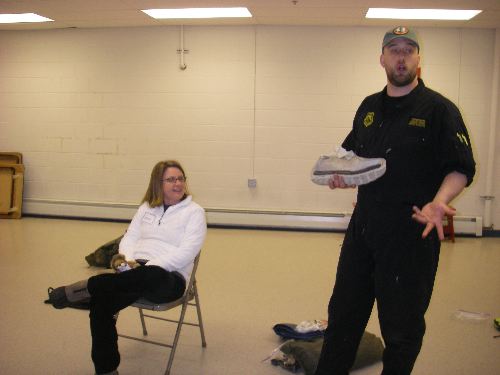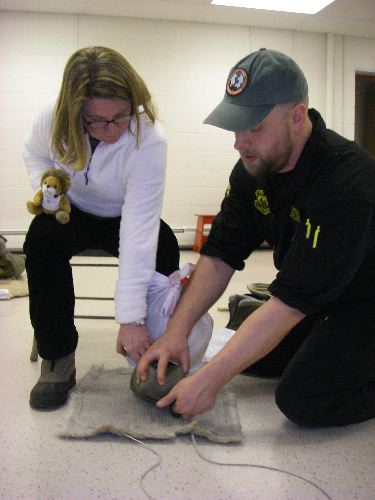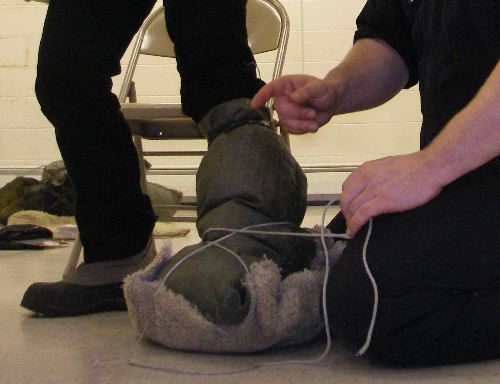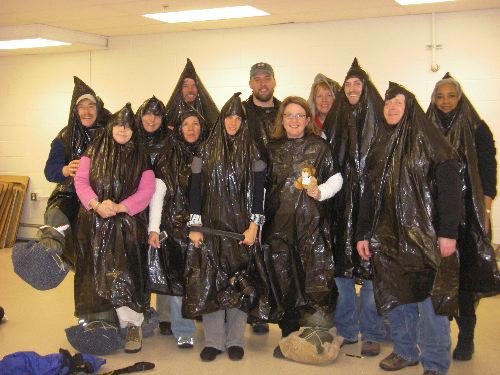To prepare for expedition conditions, the PolarTREC teachers took part in "Learn to Return" training. Tuck Brouhard of LTR Training Systems, Inc. walked us through hypothermia prevention, frostbite treatment, snow-blind precautions-- all things that a prepared traveler should know.
The most interesting segment of the training was building a functional snow boot from items typically found in expedition camps. Now teachers are excellent improvisers! We know how to scan the room, realize that what we had planned for the day is not working, and then turn to plan B (or plan C or plan D or.....). The training that Tuck provided today helped us take these great improv skills and apply them to problems in the field.
First Tuck showed us a cut-away of a Bunny Boot. This popular shoe is favored for working out on ice and snow. As you can see below, the boot has two layers of insulation below the foot, one layer above, is water-proof to protect the foot from the environment and has traction to help maintain foot on slippery surfaces.
 Cut-away Bunny Boot
Cut-away Bunny Boot
Cut-away Bunny Boot Tuck Brouhard of LTR Services holds a cut-away of a Bunny Boot to help teachers learn to improvise clothing in the field.
Next teachers constructed a boot. Using garbage bags, foam, electrical tape, an equipment bag and a piece of carpet, Tuck showed us how to duplicate the functional layers and barriers of the boot using materials at hand.
 Tuck constructs a boot on Mrs. Ward's foot.
Tuck constructs a boot on Mrs. Ward's foot.
Tuck constructs a boot on Mrs. Ward's foot. Using materials at hand and following the functional aspects of the Bunny Boot, Tuck shows Mrs. Ward how to improvise a boot!
 Tuck adds traction to Mrs. Ward's improvised boot.
Tuck adds traction to Mrs. Ward's improvised boot.
Tuck adds traction to Mrs. Ward's improvised boot. Using a piece of carpet and a native Alaskan lacing technique, Tuck added traction to Mrs. Ward's boot.
After the boot was completed, I wore it around the classroom for about 15 minutes. My foot was toasty warm, significantly warmer than my other foot, with the conventional boot on.
The last exercise we did was to make rain protection out of a trash bag. Now this is not a new idea-- I bet many of you have done this at one time or another. Tuck taught us a few tricks to make the most of this protection in the harsher environments of the field. We now know how to poke our arms through so that the trash bag makes a tight seal, trapping in precious heat, and adding a carrying pouch out of one corner of the bag.
 PolarTREC teachers model their improvised weather protection.
PolarTREC teachers model their improvised weather protection.
PolarTREC teachers model their improvised weather protection. Using a novel method, PolarTREC teachers model their improvised weather protection.
Being prepared for a variety of situations is so important to the safety and comfort of people in the field. While no one knows what challenges we may face in the field, this day of training helped us apply the concepts of improvising!
Thank you Tuck!
Gerty Ward says-- see you soon!

